Reasons and measures to combat the spider web on the rose
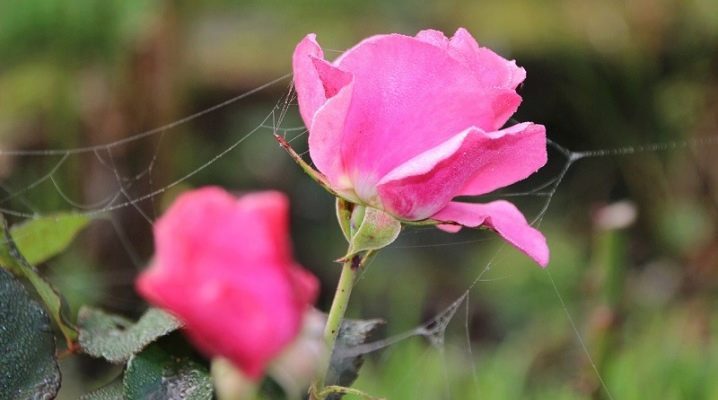
One of the most common pests of indoor or garden roses is considered to be a spider mite - a parasitic organism that is distinguished by its characteristic signs of manifestation and a significant danger to further growth or development of culture. The gardener needs to know about the basic rules for dealing with this insect.

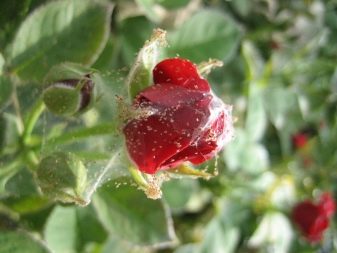
Symptoms of the appearance
The first and most important sign of the disease is the presence of cobwebs on the rose. In addition to this symptom, the pathological process can be identified by the following distinctive manifestations:
- small white spots on the leaves;
- dotted blotches of black or through holes on the buds;
- a large number of spiders on the soil and stem system.
In the presence of the above symptoms, the plant begins to wilt quickly, while its leaves rapidly dry up and fall off. If the rose is covered with a thin cobweb, and ticks or spiders appear on the foliage, this indicates a neglected disease. Due to the bright red hue and prominent signs, it is quite easy to recognize the parasites.
Once a garden or houseplant begins to dry out, it is almost impossible to preserve it. Therefore, experts recommend timely diagnostics and prevention of culture.
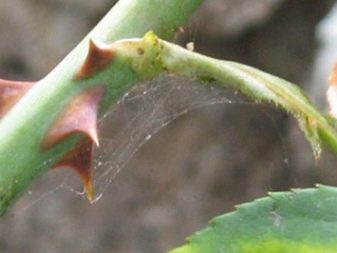

Causes of the disease
The spider mite is a harmful insect that is most commonly carried by pets or street winds. Small insects are omnivores and quite rarely die from lack of nutrients. The use of fine spider webs allows pests to travel long distances. Such insects look like ordinary ticks with a pronounced red tint.
The main reason for the appearance of parasitic organisms on rose bushes is non-observance of the rules for caring for the plant. In addition to this factor, the following points affect the occurrence of ticks:
- a weakened immune system due to previous illnesses;
- excess or lack of nutrients in the root system;
- prolonged heating of roots and soil by direct sunlight.
If this insect is not removed in a timely manner, it is able to quickly enough suck all the juices from the plant, which is why the rose rapidly dies and withers.
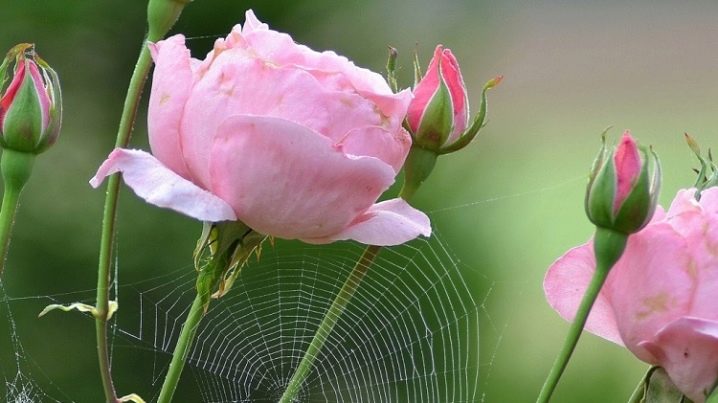
How to get rid of?
It is quite difficult to treat a plant from the negative effects and external manifestations of a spider mite, therefore, the gardener must use not one method, but several at once. Complex treatment with the use of chemical and folk remedies allows you to achieve a quick and effective elimination of pathological processes.
The first thing to do before using these or those methods of fighting the cobweb is to pre-clean the culture with a soft sponge and soapy water. This step will eliminate a large number of insects.
If the harmful lesion of the rose is not very widespread and is localized exclusively in small areas, you can use folk methods and spray with any of the prepared solutions.
- Garlic... Crush or finely chop two heads of garlic, then pour 1 liter of clean water over them. The solution is infused for 5-6 days. The resulting mixture is applied to the trunk, leaves and root system of the plant.
- Onion... Pour about 100-150 g of onion husks with 5 liters of clean water and let it brew for 6 days. Then carefully strain the resulting solution. Use the resulting mixture to spray the foliage and stem of the plant. Preventive or therapeutic actions are carried out until the spider mite disappears. You can additionally add a small amount of birch tar or green soap to the onion, which will increase the effectiveness of the solution.
- Cyclamen... Thoroughly chop several tubers of the plant, then boil them in boiling water for 60 minutes. Pour the resulting solution into a sealed vessel, insulate and put in a dry place for a day. The rose should be treated with this substance for 5-8 days.
- Alcohol... The classic method for cleaning a spider mite. For this, the leaves and trunk are carefully treated with a medical solution. Despite the high efficiency of the method, it can quickly eliminate insects directly, but not their eggs.
- Dandelion... Thoroughly chop small root parts of medicinal dandelion (about 30-40 grams) and fill with clean water in a volume of 1 liter. Next, infuse the solution for 3-4 hours. With the resulting substance, gently wipe the foliage of the rose for 1 week.
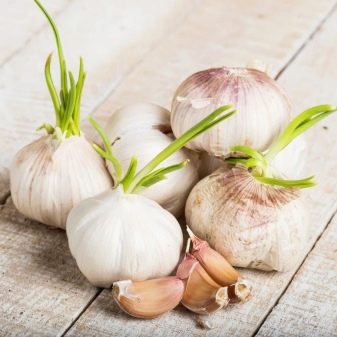
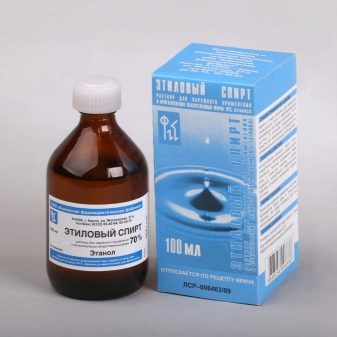
In addition to the above methods, a method in which pathological manifestations and spider mites are eliminated by the introduction of predatory insects such as phytoseiulus, goldilocks and amblyiseus shows high efficiency... The above insects are usually purchased from specialized stores or private households. After 1-2 days after the introduction, the predator is able to eat up to 10 spider mites and 20 eggs. The more insects are added to the plant, the more effective the result will be.
In addition to traditional methods of dealing with the manifestations of a spider mite, you can use specialized chemical-based preparations. For this, so-called acaricides are often used.
- "Alatar"... It is the most effective and toxic agent against spider mites. In the process of processing, the gardener must use gloves, a medical mask and closed clothing. This drug is only used in a well-ventilated area or outdoors.
- Fitoverm. A distinctive feature of the product is less toxicity, which is why it can be used indoors. Despite the low virulence rate, it is important to follow the precautions described above during processing. With the help of this drug, the tick can be eliminated quickly - in 5-7 days.
- "Tiovit Jet"... Fights parasitic organisms and larvae quickly and effectively. Complete extermination of unwanted insects is observed after 2-3 applications. An effective analogue is the domestic remedy "Iskra" or "Neoron".
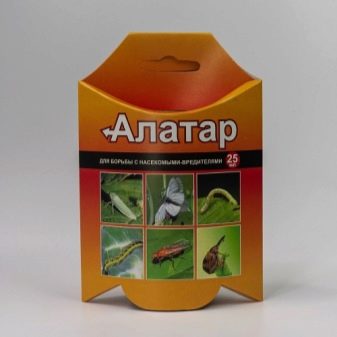

Prevention measures
The basis for the prevention of spider mites is competent systematic care for an adult plant. For any rose, it is especially important to maintain optimal humidity and temperature conditions, as well as monitor fertilization and irrigation schedule. Flowers are periodically sprayed with a spray bottle, and organic compounds are used as top dressing.
Following the rules of care allows you to effectively maintain strong immunity in the culture, additionally protecting the foliage, root system and stems from the negative effects of certain pests. It is also especially important to remove spoiled or dry leaves in a timely manner, examine buds for the presence of mites and monitor the quality of the soil mixture. As practice shows, the sooner pests or any symptomatic manifestations are detected, the easier they are to be destroyed. In addition to the preventive measures described above, it is necessary to ensure that there are no signs of rot on the foliage or root system.
We recommend using a regular soap-based solution to wipe down pots, window sills or additional trays. Also, it is better not to put orchids near roses - this culture is highly susceptible to the formation and reproduction of pathogenic microorganisms.
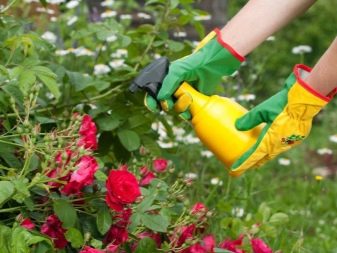
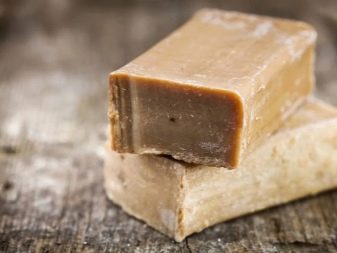

































































































The comment was sent successfully.